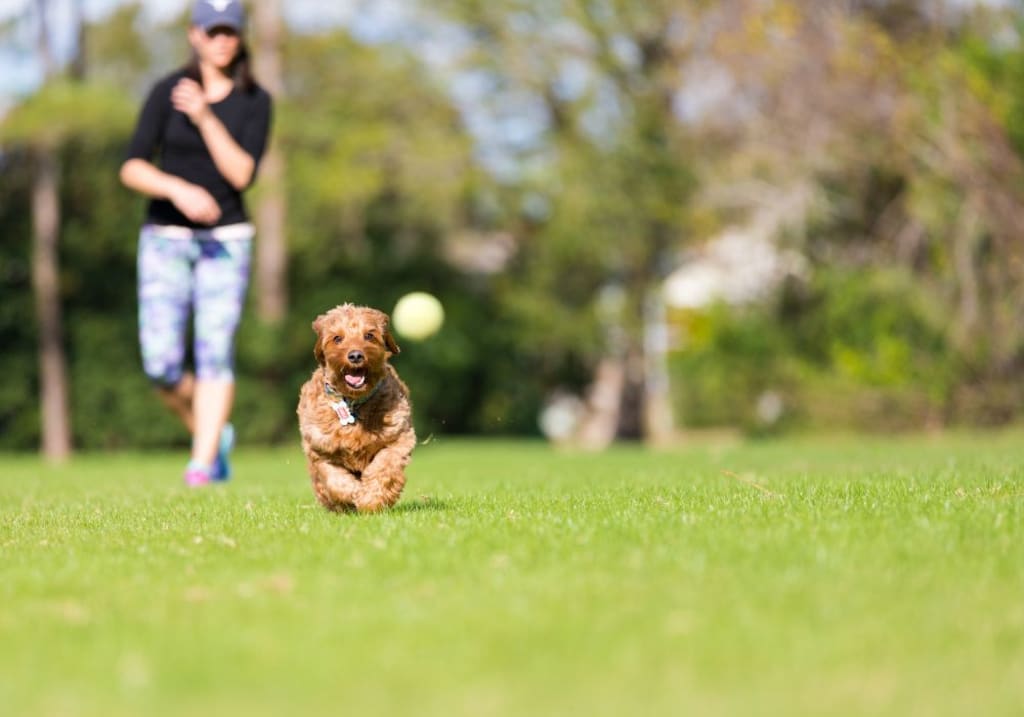Comprehensive Training Tips for Teaching Your Dog the Ultimate Retrieval Game
Mastering the Art of Fetch

Unlock Your Dog's Innate Retrieving Instincts and Turn Fetch into a Rewarding Bonding Experience
Playing fetch is a classic game that dogs of all breeds and ages can enjoy. It taps into their natural instincts as hunters and scavengers, providing both physical and mental stimulation. But teaching a dog to fetch and retrieve properly takes time, patience, and the right training approach.
In this comprehensive guide, we'll walk you through a step-by-step process to help your canine companion master the art of fetch. From building initial interest and engagement to perfecting the "drop it" command and increasing distance, you'll learn effective positive reinforcement techniques to make fetch training an enriching and rewarding experience for both you and your dog.
Whether you have a rambunctious puppy or an older dog who's never played fetch before, this guide will equip you with the tools and strategies to turn your four-legged friend into a fetch pro. Get ready to bond, exercise, and have fun as you unlock your dog's full retrieving potential!
The Benefits of Teaching Your Dog to Fetch
Fetch is more than just a fun game - it offers a wealth of benefits for your canine companion:
1. Physical and Mental Stimulation
Chasing after a thrown object and bringing it back engages your dog's natural prey drive, providing both physical exercise and mental stimulation. This helps prevent boredom and keeps your pup's mind active.
2. Improved Obedience and Recall
The "fetch" and "drop it" commands are excellent obedience training tools. Mastering these skills lays the foundation for more advanced training and helps reinforce your role as the leader.
3. Stronger Bond with You
Playing fetch is a wonderful way to bond with your dog. The one-on-one interaction, rewards, and shared enjoyment of the game strengthen the human-canine connection.
4. Versatility in Sports and Activities
For sporting and working dog breeds, fetch can be an invaluable skill. It's a key component in many canine sports like agility, flyball, and dock diving. Even non-sporting dogs can benefit from fetch training.
5. Curbing Destructive Behaviors
A dog that's mentally and physically engaged is less likely to develop unwanted behaviors like chewing, digging, or excessive barking. Fetch provides a healthy outlet for their energy.
Now that you know the benefits, let's dive into the step-by-step process of teaching your dog to fetch.
Step 1: Introduce the Fetch Toy and Build Interest
The first step in fetch training is to find the right toy that will capture your dog's attention and excitement. This could be a tennis ball, a plush toy, or a specialized fetch toy like a rubber bumper or a Tug-E-Nuff tug toy.
Start by letting your dog sniff and interact with the toy. Encourage them to mouth and play with it by moving it around and engaging them in a brief tug-of-war session. This helps build their initial interest and association between the toy and positive reinforcement.
Tip: Use High-Value Rewards
To make the game even more enticing, use small, high-value treats or your dog's favorite snacks as rewards during this initial phase. The goal is to create a strong positive connection between the toy and the delicious payoff.
Tip: Vary the Toys
While it's good to have a "fetch toy" that your dog recognizes, you can also introduce different objects to keep the game interesting. Just make sure they're safe, durable, and appropriate for your dog's size and chewing habits.
Step 2: Teach the "Fetch" Command
Once your dog is comfortable with the toy, it's time to introduce the "fetch" command. Start by holding the toy close to your dog and encouraging them to grab it. As soon as they take it in their mouth, say "fetch" in a cheerful tone and reward them with praise and treats.
Gradually increase the distance you throw the toy, always rewarding your dog when they pick it up and start to bring it back to you. If they get distracted or lose interest, go back to shorter distances until they regain focus.
Tip: Use a Consistent Cue
Choose a single, clear command like "fetch," "get it," or "bring it" and stick to it. This helps your dog associate the verbal cue with the desired behavior.
Tip: Praise and Reward
Enthusiastic praise, treats, and playtime are essential for reinforcing the "fetch" behavior. The more positive the experience, the more motivated your dog will be to keep playing.
Step 3: Teach the "Drop It" Command
An essential part of fetch training is teaching your dog to release the toy on command. This "drop it" skill ensures a smooth, continuous flow of the game and prevents your dog from becoming possessive of the toy.
Start by offering a high-value treat as your dog is holding the toy. As they open their mouth to take the treat, say "drop it" in a calm, firm voice. Once they release the toy, praise and reward them immediately.
Gradually phase out the treat and rely more on praise and play as the reward for dropping the toy. This teaches your dog that giving up the object is a positive experience, not a loss.
Tip: Be Patient and Consistent
Some dogs may be more reluctant to give up their toys than others. Stick with the training, and be patient and consistent in your approach. Avoid snatching the toy away, as this can reinforce the undesirable behavior.
Step 4: Increase Distance and Distractions
Once your dog has mastered the basic "fetch" and "drop it" commands, it's time to start increasing the distance and adding distractions to the training.
Begin by throwing the toy a little farther away, gradually increasing the distance over multiple sessions. Reward your dog each time they successfully retrieve the toy and bring it back to you.
Next, introduce mild distractions like having family members or other pets nearby. Gradually increase the level of distraction, always ensuring your dog can still focus on the task at hand. Reward them for maintaining their attention and completing the fetch sequence.
Tip: Start Indoors and Gradually Move Outdoors
It's best to begin fetch training in a quiet, indoor environment with minimal distractions. Once your dog has a solid grasp of the commands, slowly transition to outdoor settings, such as a fenced backyard or a quiet park. This helps them learn to focus despite the increased stimuli.
Step 5: Troubleshoot Common Challenges
As you progress through the fetch training process, you may encounter some common challenges. Here are a few tips to help you overcome them:
My Dog Won't Bring the Toy Back
- If your dog is more interested in playing keep-away than returning the toy, try the following:
- Reward them heavily when they do bring the toy back to you, using high-value treats or engaging playtime.
- Avoid chasing or running after your dog, as this can reinforce the undesirable behavior.
- Practice the "drop it" command in different contexts to solidify the behavior.
Consider using a long training leash to gently guide your dog back to you if they try to run off.
My Dog Drops the Toy Too Soon
- If your dog tends to drop the toy before reaching you, try these strategies:
- Gradually increase the distance you throw the toy, allowing them to build up the drive to retrieve it.
- Reward them for holding the toy for longer periods before giving the "drop it" command.
Use a toy that's more challenging for them to hold, such as a bumper or a tug toy.
My Dog Gets Distracted Easily
- If your dog struggles to focus on the fetch game, try these tips:
- Start training in a quiet, low-stimulus environment and slowly introduce distractions.
- Use high-value treats or toys to keep your dog engaged and motivated.
- Incorporate play breaks and shorter training sessions to maintain their attention.
- Consider using a long line or leash to prevent your dog from wandering off.
Remember, every dog learns at their own pace, and what works for one pup may not work for another. Be patient, adaptable, and keep the training sessions positive and fun. With consistent practice, your dog will be fetching like a pro in no time!
Accessories and Gear for Fetch Training
While you don't need a lot of specialized equipment to teach your dog to fetch, having the right accessories can make the training process easier and more enjoyable. Here are some recommended items:
Fetch Toys
- Tennis balls or rubber balls
- Plush or squeaky toys
- Durable rubber or canvas bumpers
- Tug-E-Nuff tug toys
Training Treats
- High-value, low-calorie treats like freeze-dried meat or fish
- Soft, chewy treats that are easy to break into small pieces
- Treats that contain beneficial nutrients like glucosamine or DHA
Other Gear
- Long training leash or line (for outdoor practice)
- Clicker (for positive reinforcement training)
- Treat pouch or bag (to keep rewards handy)
Remember to choose toys and treats that are appropriate for your dog's size, age, and chewing abilities. Supervise playtime and fetch sessions to ensure your pup's safety.
Conclusion
Teaching your dog to fetch is a rewarding journey that strengthens the bond between you and your canine companion. By following the step-by-step process outlined in this guide, you'll unlock your dog's natural retrieving instincts and turn fetch into a fun, enriching game.
Remember to be patient, consistent, and positive throughout the training process. With the right techniques and plenty of praise and rewards, your dog will soon be fetching like a pro, providing endless hours of exercise, mental stimulation, and quality time together.
So, what are you waiting for? Grab your dog's favorite toy and get ready to master the art of fetch!
About the Creator
Hasan
Welcome...
In this site of mine you can learn amazing things and many information that you don't know so please subscribe to my site.
Enjoyed the story? Support the Creator.
Subscribe for free to receive all their stories in your feed. You could also pledge your support or give them a one-off tip, letting them know you appreciate their work.






Comments
There are no comments for this story
Be the first to respond and start the conversation.